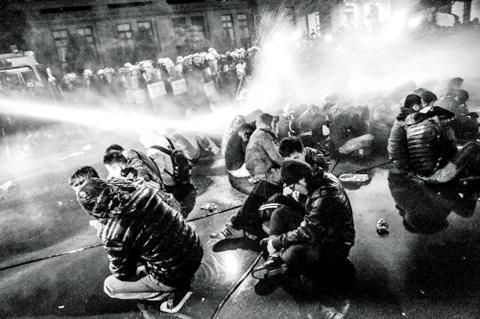Six months after the 24-day occupation of Legislative Yuan, Sunflower participants and supporters will return to the scene tonight — not to protest, but to watch Sunflower Occupation (太陽.不遠), a compilation of nine short documentaries that explore the multiple aspects of the movement and the various issues it raises.
Shortly after the students and activists occupied the legislative floor on March 18, the Taipei Documentary Filmmakers’ Union (台北市紀錄片從業人員職業工會) initiated the collective project and called on filmmakers to join. Eventually, 10 directors, 26 cinematographers and dozens of animators, editors, musicians and volunteers answered the call to create the standalone shorts, funded by 3,154 individual sponsors on VDemocracy.com, a crowdfunding platform for social movements.
Each work tackles a specific theme or issue. The Night of Enlightenment (一夜之間我長大), for example, brings viewers back to the night when the violent crackdown on students occupying the Executive Yuan left many wounded, disenchanted and politically enlightened. Student leader Chen Wei-ting (陳為廷) takes center stage in A Commander Made by Accident (不小心變成總指揮), which offers an honest portrait of Chen’s transformation as an activist. History is revisited in 1990 (我們的1990), revealing how Taiwan has gone through the Wild Lilies (野百合學運) student movement in 1991 to the Sunflowers, as seen through the eyes of former Wild Lilies.

Photo courtesy of Activator Marketing Company
Tonight’s event will take place on Jinan Road (濟南路) outside the legislature. The outdoor screening will start at 7pm, followed by a brief talk by two participating filmmakers He Chao-ti (賀照緹) and Tsai Tsung-lung (蔡崇隆).
After tonight’s screening, the film will tour to 17 cities and towns across the country from tomorrow to Nov. 16. All screenings are free. Those interested need to sign up through www.accupass.com, where screening schedules and venue information are available.
More information about the project can be found on its Facebook fan page at www.facebook.com/318doc.

Oct. 27 to Nov. 2 Over a breakfast of soymilk and fried dough costing less than NT$400, seven officials and engineers agreed on a NT$400 million plan — unaware that it would mark the beginning of Taiwan’s semiconductor empire. It was a cold February morning in 1974. Gathered at the unassuming shop were Economics minister Sun Yun-hsuan (孫運璿), director-general of Transportation and Communications Kao Yu-shu (高玉樹), Industrial Technology Research Institute (ITRI) president Wang Chao-chen (王兆振), Telecommunications Laboratories director Kang Pao-huang (康寶煌), Executive Yuan secretary-general Fei Hua (費驊), director-general of Telecommunications Fang Hsien-chi (方賢齊) and Radio Corporation of America (RCA) Laboratories director Pan

The classic warmth of a good old-fashioned izakaya beckons you in, all cozy nooks and dark wood finishes, as tables order a third round and waiters sling tapas-sized bites and assorted — sometimes unidentifiable — skewered meats. But there’s a romantic hush about this Ximending (西門町) hotspot, with cocktails savored, plating elegant and never rushed and daters and diners lit by candlelight and chandelier. Each chair is mismatched and the assorted tables appear to be the fanciest picks from a nearby flea market. A naked sewing mannequin stands in a dimly lit corner, adorned with antique mirrors and draped foliage
The consensus on the Chinese Nationalist Party (KMT) chair race is that Cheng Li-wun (鄭麗文) ran a populist, ideological back-to-basics campaign and soundly defeated former Taipei mayor Hau Lung-bin (郝龍斌), the candidate backed by the big institutional players. Cheng tapped into a wave of popular enthusiasm within the KMT, while the institutional players’ get-out-the-vote abilities fell flat, suggesting their power has weakened significantly. Yet, a closer look at the race paints a more complicated picture, raising questions about some analysts’ conclusions, including my own. TURNOUT Here is a surprising statistic: Turnout was 130,678, or 39.46 percent of the 331,145 eligible party

The election of Cheng Li-wun (鄭麗文) as chair of the Chinese Nationalist Party (KMT) marked a triumphant return of pride in the “Chinese” in the party name. Cheng wants Taiwanese to be proud to call themselves Chinese again. The unambiguous winner was a return to the KMT ideology that formed in the early 2000s under then chairman Lien Chan (連戰) and president Ma Ying-jeou (馬英九) put into practice as far as he could, until ultimately thwarted by hundreds of thousands of protestors thronging the streets in what became known as the Sunflower movement in 2014. Cheng is an unambiguous Chinese ethnonationalist,